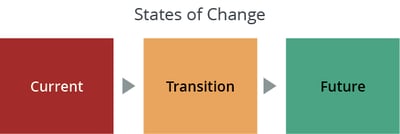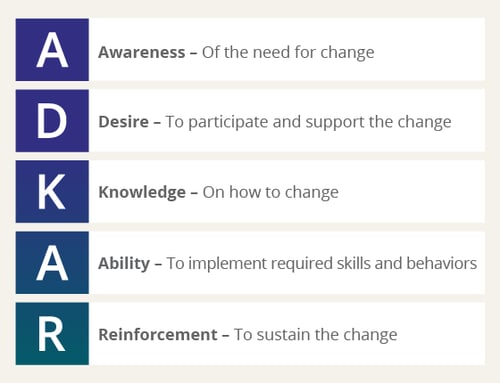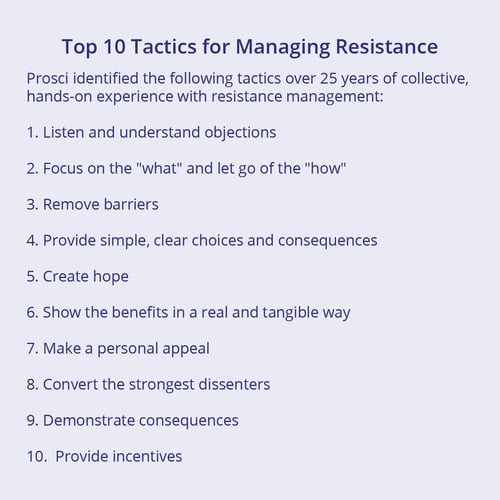How to Manage Resistance to Desirable Change

5 Mins
Published: May 3, 2023

Change management comprises many strategies, tools and techniques for managing the people side of change, and resistance management is a critical aspect of the work. That's because resistant behaviors are a natural response to change that all people have, even when the change is widely considered positive.
Desirable Changes and Resistance
In change management, we tend to think resistance arises because employees are comfortable in the current state. But in some cases, the organization and people actually desire the change:
- "The current system is so broken and dysfunctional that it is negatively impacting our business operations, relationships with clients and customers, and supply chain processes."
- "The change is so great and comes with so many benefits, we can't wait to leave the current state behind."

- Awareness – Prosci's Best Practices in Change Management research consistently shows that lack of awareness is the greatest contributor to employee resistance. Because awareness of the need to change has already been established in the scenario above, the chances of this causing resistance are significantly lower.
- Desire – Many change practitioners understand that desire to participate and support the change is another potentially strong barrier to change because desire ultimately requires a personal choice and can be difficult to influence. These change scenarios are either very necessary or they offer great benefits to those impacted, so the desire to participate practically establishes itself.
 If this is the type of reaction you are experiencing, your project or initiative is in good shape, right?
If this is the type of reaction you are experiencing, your project or initiative is in good shape, right?
Well, what happens when, even with awareness and desire seemingly in place, people still exhibit resistant behaviors in the face of change?
Resistance is the natural human reaction to any type of change because it requires people to move from a current state where they are familiar and comfortable with processes and daily tasks, to an unfamiliar future state. Change is difficult, no matter how necessary or good the change may seem.
Learn how to manage resistance and help impacted people overcome barriers to adoption when you attend
the Prosci Change Management Certification Program.
Examples of Desirable Changes
As a change practitioner, you accept that resistance is normal. But it can still catch you off guard when the change is perceived as desired by employees. In these situations, we need to develop an understanding of why the resistant behaviors are happening, so we can determine what to do about it.
Consider a few examples:
Change A
An organization is implementing a new email system because the current system is unreliable and employees are frequently receiving failure-to-send notices. Additionally, it is difficult for employees to access and navigate their email account away from the office, causing disruption in daily communications.
Change B
An organization is changing office locations. The current building where the company is located is old and has many structural problems that affect the employees' day-to-day activities. The company will relocate to a building that is nearby and has been recently renovated.
Change C
An organization is implementing a new benefits package that offers broader healthcare coverage and higher bonus incentives.
In each of these examples, either the change has such excellent benefits for those impacted that resistance is expected to be minimal or nonexistent (Change C), or the current way of doing things is so broken that employees are eager and excited to move to the future state (Changes A and B).
Steps to Address
Resistance to Desirable Change
Even when changes significantly improve the current state or when the future state greatly benefits employees, resistant behaviors will emerge. If you are managing such changes, you must first understand what is happening, where the resistance is coming from, and why. What actions can you take to help people who are struggling with the change overcome barriers to adoption, so your project or initiative stays on track?
Step 1. Establish frameworks
There are two frameworks at play in these situations: 1) A desirable change does not mean everyone will desire it, and 2) Resistance does not always mean there is a lack of desire. These frameworks will help you understand resistance more clearly and manage it more effectively.
Step 2. Conduct root-cause analysis
Personal and organizational contexts can influence speed of adoption, ultimate utilization, and proficiency with a change on an individual level. With the frameworks from Step 1 in mind, you can begin to conduct analyses and perform assessments to identify and understand the root causes of resistance.
Let's take a closer look at the resistance and root causes from our examples of desirable changes:
Change A (Email system)
Amir has been unable to fully configure the new email system and is afraid to speak up for fear of being bothersome or appearing incompetent, so Amir avoids using the new email system altogether.
The framework to apply is "A lack of desire is not always the cause of resistance." After further analysis, it has become apparent that the employee lacks the knowledge to effectively configure the new email system, even though the desire to use the new system is in place.
Change B (Office location)
As much as Gabriela is looking forward to her new office, she is slow to move her files and supplies out of her old workspace. The change of work environment, adapting to the new work space, getting reorganized makes her feel uncomfortable and unsettled.
Even though Gabriela desires the new future state, the messiness of the transition state is causing difficulties. Her behaviors appear to demonstrate that she doesn't desire to move, but in reality she might just need more time to adjust.
Change C (Benefits package)
Although the bonus incentive amount has increased with the new benefits package, employees are now receiving bonus checks only twice a year instead of quarterly. Elijah resists the change initially because he had intended to purchase a new car with his upcoming quarterly bonus check and now must wait longer.
On the surface, the change seemed desirable because of its beneficial monetary impact on employee bonus checks. However, in Elijah's case, the change from quarterly to semi-annual payment is the source of resistance because it has disrupted his personal plans.

Step 3. Develop your approach
Prosci's resistance management approach is primarily proactive and preventive, with steps woven throughout the Prosci 3-Phase Process from the earliest stages of change management planning. As one of the three main components of the Prosci Methodology, the process requires you to consider the impacts of a change on people and groups, and address critical issues before they occur. Yet, some resistance will still emerge, as in our Change A, B and C examples.
To address persistent resistance, you can:
- Engage key players
People managers play an important role because they are closest to people who work with the changes to their daily work. Your role as a change practitioner includes preparing and equipping people managers to manage resistance in their teams. For example, if Elijah is experiencing a barrier to the adopting a change because he will receive bonus checks less frequently, his people manager needs to work closely with him to build individual awareness of the need for change and remove barriers to his successful transition. - Be an advocate and coach
In situations where you're facing resistance to a desirable change, sometimes what's needed is an advocate and coach. If the resistance stems from a lack of knowledge for configuring a new email system, perhaps all that is needed is some one-on-one coaching and advocating for the change to ensure that people like Amir receive the additional support needed to build knowledge on how to configure the new account. - Employ the Top 10 Tactics for Managing Resistance
If resistance persists, you may need to apply additional resistance management tactics. For example, it's understandable that it can take time to adjust to a new work environment after a move, as Gabriela is experiencing. But if the resistant behavior becomes enduring and persistent, it may be necessary to use more concrete methods, such as offering simple, clear choices and consequences.
 Manage Resistance During Change
Manage Resistance During Change
To manage resistance to change, you must first understand what it is and why it occurs. By identifying root causes, you can find effective ways to help people overcome their individual barriers to change. Doing so equips you to recognize, analyze and address even the most unique situations when unexpected resistance arises.



